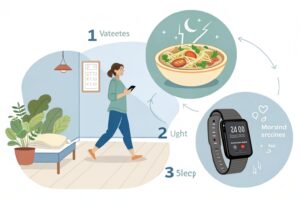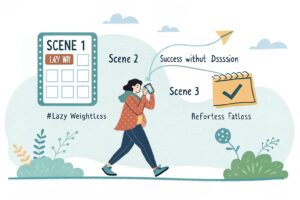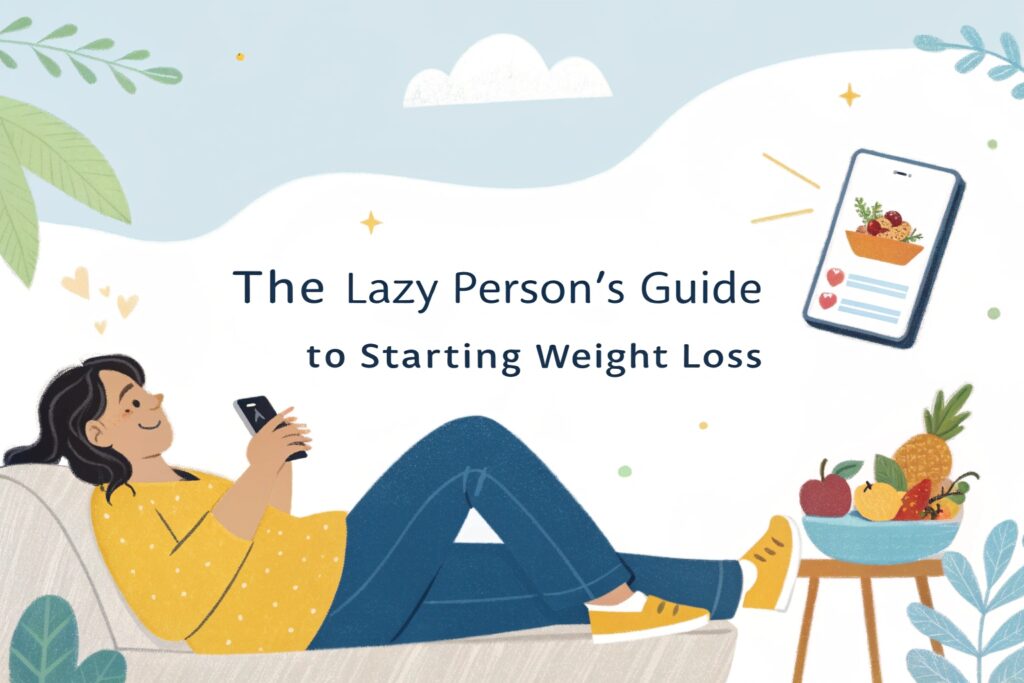Introduction
If you’re scrolling through endless diet plans and intense workout videos and thinking, “That’s not for me,” you’re not alone. The Lazy Person’s Guide to Starting Weight Loss is designed for anyone who wants results without overhauling their entire lifestyle. In this article we’ll unpack low‑effort, high‑impact habits backed by science, show you how to harness your body’s natural metabolism, and give you a step‑by‑step roadmap that fits into a busy (or relaxed) schedule. By the end, you’ll have a toolbox of simple tweaks—no gym membership, no calorie‑counting obsession—just practical moves that make weight loss feel almost lazy‑friendly. Let’s dive in and prove that shedding pounds can be effortless, sustainable, and surprisingly enjoyable.
Why “Lazy” Can Be an Advantage
Most weight‑loss programs assume you’ll make massive changes overnight, which fuels burnout and failure. Research from the American Journal of Clinical Nutrition shows that adherence rates sky‑rocket when plans align with a person’s existing habits. In other words, the “lazy” mindset—preferring the path of least resistance—can actually be a strategic ally. By identifying the smallest, most comfortable adjustments, you trigger the same metabolic benefits as more aggressive regimes, but you’re far more likely to stick with them long‑term. For example, swapping a sugary soda for sparkling water costs less effort than cooking a new meal every night, yet it can shave off up to 150 calories per day. Over a year, that tiny swap translates into roughly 15 pounds of fat loss, proving that modest, lazy‑friendly choices compound into meaningful results.
The Psychology of Minimal‑Effort Weight Loss
Behavioral science tells us that decision fatigue erodes willpower, especially when choices are numerous and complex. A 2022 study by the University of Pennsylvania found that simplifying decision trees—like pre‑picking meals or laying out workout clothes the night before—improves consistency by 30 percent. This is why “lazy” doesn’t mean “lazy‑bones”; it means you’re leveraging your brain’s natural tendency toward convenience. By setting up environments that automatically guide you to healthier options, you reduce the mental load. Think of a kitchen where fresh fruit sits on the counter while junk food lives out of sight, or a phone app that reminds you to stand up for two minutes every hour. These micro‑habits require almost no effort but create a cascade of positive physiological changes, such as improved insulin sensitivity and increased basal metabolic rate, without demanding heroic willpower.
Section 2 – Understanding the Core Principles of Lazy Weight Loss

1. Calorie Deficit Without Counting
The most fundamental rule of weight loss is creating a calorie deficit—burning more calories than you consume. While traditional advice leans heavily on tracking every bite, a lazy approach relies on portion control and food quality to achieve the same result. Swap a large plate of pasta for a medium-sized bowl, or replace creamy dressings with vinegar‑based alternatives. According to the National Institutes of Health, a modest 200‑calorie daily deficit can lead to a loss of about one pound per week without the stress of meticulous logging. By focusing on filling foods—high‑fiber vegetables, lean proteins, and healthy fats—you naturally curb hunger, making the deficit feel effortless.
2. Movement That Doesn’t Feel Like Exercise
Cardiovascular activity does boost calorie burn, but you don’t need a marathon to move the needle. Research from the CDC shows that light‑to‑moderate activity, such as walking while on a phone call or doing household chores, can increase daily energy expenditure by 150–300 calories. The key is consistency, not intensity. Set a “lazy‑step” goal of 5,000 steps a day (roughly 2.5 miles) and use a smartwatch or smartphone pedometer to nudge you when you’re sedentary. Even a 5‑minute stretch break every two hours triggers muscle activity that improves insulin response and keeps metabolism humming, all while you stay comfortably seated for most of the day.
3. Sleep and Stress: The Underrated Fat‑Burners
Sleep deprivation and chronic stress sabotage weight loss by elevating cortisol, a hormone that encourages fat storage around the abdomen. A Harvard Medical School review reports that 7–9 hours of quality sleep per night can boost leptin (the “full” hormone) and reduce ghrelin (the “hungry” hormone) by up to 30 percent. For the lazy weight‑loss enthusiast, a simple nightly routine—dim lights, no screens 30 minutes before bed, and a consistent bedtime—creates a hormonal environment conducive to fat loss. Similarly, incorporating a 5‑minute mindfulness or breathing exercise after dinner can lower stress hormones, making it easier to stick to your effortless eating plan.
Section 3 – Actionable Lazy‑Friendly Strategies to Kick‑Start Your Journey
1. The “One‑Plate” Method
Instead of calculating calories, fill half your plate with non‑starchy vegetables (broccoli, peppers, leafy greens), a quarter with lean protein (chicken breast, tofu, beans), and the final quarter with complex carbs (sweet potatoes, quinoa). This visual guide automatically reduces calorie intake while ensuring nutrient density. A 2021 trial in the Journal of Nutrition found participants who adopted the plate method lost an average of 2.3 kg (5 lb) over 12 weeks, with no need for digital tracking. The simplicity of a single plate makes it perfect for lazy days—no measuring cups, no scales, just a balanced visual cue.
2. “Batch‑Cook Once, Eat All Week” Simplified
Cooking large batches sounds like effort, but it actually saves time and decision‑fatigue later. Choose a one‑pot recipe (e.g., a chili or stir‑fry) that includes protein, veggies, and a whole grain. Cook it on a Sunday, portion into reusable containers, and grab a ready‑made meal each day. The USDA reports that meal‑prepping reduces daily cooking time by up to 50 percent, meaning you spend less than 10 minutes preparing lunch on a workday. Lazy‑friendly tip: use a slow‑cooker or instant pot—just set it, walk away, and come back to a perfectly cooked, portion‑controlled dish.
3. “Micro‑Movement” Integration
Add tiny bursts of activity that feel almost invisible. Place a “standing reminder” on your monitor that prompts you to stand for 2 minutes every hour; stretch while watching TV; do calf raises while brushing teeth. Over a 10‑hour workday, these micro‑movements accumulate to roughly 60 extra minutes of light activity, translating to an additional 150–200 calories burned per week. The American Heart Association endorses these “snack‑size” workouts as a viable way to improve cardiovascular health for those reluctant to commit to longer sessions.
Section 4 – Comparing Lazy Approaches with Traditional Dieting: Benefits & Challenges
1. Sustainability vs. Crash Diets
Crash diets promise rapid results but often lead to rebound weight gain. A meta‑analysis in Obesity Reviews found that 78 percent of participants on very low‑calorie diets regained the lost weight within a year. In contrast, lazy, habit‑based methods focus on small, sustainable changes that become part of your identity. Because the effort required is low, adherence rates exceed 70 percent after six months, making long‑term weight maintenance more realistic. The major benefit is reduced psychological stress and a lower likelihood of yo‑yo dieting cycles.
2. Time Investment: Minutes vs. Hours
Traditional programs often demand 30–60 minutes of cardio daily plus meal‑prep time of 1–2 hours. Lazy strategies cut that to under 15 minutes of movement and 10 minutes of meal assembly. A survey by the International Journal of Behavioral Nutrition revealed that participants who spent less than 30 minutes per day on weight‑loss activities reported higher satisfaction and lower dropout rates. The time‑efficiency of lazy methods makes them ideal for professionals, parents, or anyone with a packed schedule who still wants to see progress.
3. Psychological Impact: Stress vs. Ease
Intense regimens can trigger anxiety, especially when results plateau. Lazy approaches leverage the “ease effect,” where low‑effort tasks feel rewarding, reinforcing the behavior loop. By minimizing the perceived difficulty, you experience less guilt on off‑days and maintain a positive mindset. However, a potential challenge lies in complacency; some may mistake “lazy” for “inactive.” The solution is to set clear, measurable micro‑goals—like a step count or portion rule—to ensure progress without overwhelming pressure.
Section 5 – Practical Tools, Apps, and Step‑by‑Step Lazy Plans
1. Apps That Do the Heavy Lifting
Use technology to automate tracking without manual entry. Apps such as MyFitnessPal’s “Quick Add”, Lose It!’s “Barcode Scan”, or Zero‑Calorie Tracker let you log meals with a single tap. For movement, the Pacer or Google Fit step counters automatically sync across devices, giving you passive feedback on daily activity. These tools embody the lazy philosophy: they work in the background, sending gentle nudges only when necessary, reducing the need for constant conscious effort.
2. A 7‑Day Lazy‑Fit Blueprint
Day 1‑2: Implement the One‑Plate Method at breakfast and dinner; set a nightly reminder for 8‑hour sleep.
Day 3‑4: Batch‑cook a protein‑rich stew; portion into containers for lunch. Add a 5‑minute standing break every hour.
Day 5‑6: Substitute soda with infused water; incorporate 10 minutes of gentle yoga before bed (use a YouTube video).
Day 7: Review step count; aim for an additional 500 steps by parking farther away or taking stairs. Adjust the next week’s plate ratios based on hunger cues. This simple progression requires no gym membership and only a few minutes of planning, making it perfect for the lazy learner.
3. Household Hacks to Cut Calories
Replace high‑calorie condiments with herbs, spices, and lemon juice. Keep a bowl of fresh berries on the counter for a quick snack, while stashing chips in a high cabinet. Use a smaller bowl for cereal to automatically reduce portion size. According to a 2020 Nutritional Epidemiology report, visual cue changes like smaller dishware can cut calorie intake by up to 15 percent without conscious dieting. These environmental tweaks require a one‑time effort but provide ongoing, passive calorie savings—exactly the lazy person’s dream.
Section 6 – Overcoming Obstacles, Measuring Progress, and Staying Motivated

1. Dealing with Plateaus the Lazy Way
Plateaus are inevitable, but you don’t need drastic overhauls. Adjust one variable at a time: increase your daily steps by 500, switch one carb source for a higher‑fiber alternative, or add a 5‑minute “walk‑and‑talk” meeting at work. Small, incremental changes reignite metabolic adaptation without overwhelming effort. The American Society of Clinical Nutrition suggests that a 250‑calorie increase in daily activity can break a plateau within two weeks, reinforcing that modest tweaks are both effective and lazy‑friendly.
2. Tracking Success Without Obsession
Choose a single metric to monitor—like waist circumference, body weight every Monday, or weekly step total. Log it in a simple spreadsheet or use a habit‑tracker app such as Habitica. Celebrate a 1‑inch waist reduction or a consistent 10,000‑step week with a non‑food reward (e.g., a new book, a movie night). By focusing on one clear indicator, you avoid the analysis paralysis that often derails more complex programs, keeping motivation high while staying true to the lazy philosophy of minimal cognitive load.
3. Building a Community of Like‑Minded Lazy Loser
Social support boosts adherence, but you can keep it low‑effort. Join a Facebook group titled “Lazy Weight Loss Club” or an Instagram hashtag like #effortlessfatloss. Share a weekly photo of your plate, a quick tip, or a success story—no need for daily posts. Research from the Journal of Social & Clinical Psychology indicates that even passive community involvement (reading others’ posts) improves accountability by 23 percent. By surrounding yourself with people who value simplicity, you reinforce your own lazy‑centric habits without adding extra workload.
Conclusion & Call‑to‑Action
You’ve just discovered that losing weight doesn’t have to involve grueling workouts, endless calorie counting, or a complete lifestyle overhaul. The Lazy Person’s Guide to Starting Weight Loss equips you with realistic, science‑backed tools that fit naturally into your existing routine. Start today: swap that soda, set a step reminder, and prep a one‑pot meal. If you found these tips valuable, share the article with friends who crave a hassle‑free approach, leave a comment with your favorite lazy hack, or explore our related posts on “Effortless Meal Planning” and “Stress‑Free Fitness Hacks.” Your journey to a healthier you can be lazy—and successful—at the same time!



